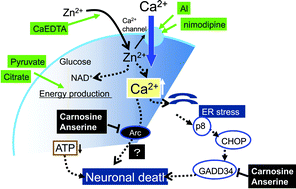Protective activity of carnosine and anserine against zinc-induced neurotoxicity: a possible treatment for vascular dementia
Abstract
Carnosine (β-alanyl-L-histidine) is a small dipeptide with numerous beneficial effects, including the maintenance of the acid–base balance, antioxidant properties, chelating agent, anti-crosslinking, and anti-glycation activities. High levels of carnosine and its analogue anserine (1-methyl carnosine) are found in skeletal muscle and the brain. Zinc (Zn)-induced neurotoxicity plays a crucial role in the pathogenesis of vascular dementia (VD), and carnosine inhibits Zn-induced neuronal death. Here, the protective activity of carnosine against Zn-induced neurotoxicity and its molecular mechanisms such as cellular Zn influx and Zn-induced gene expression were investigated using immortalised hypothalamic neurons (GT1-7 cells). Carnosine and anserine protected against Zn-induced neurotoxicity not by preventing increases in intracellular Zn2+ but by participating in the regulation of the endoplasmic reticulum (ER) stress pathway and the activity-regulated cytoskeletal protein (Arc). Accordingly, carnosine and anserine protected against neurotoxicity induced by ER-stress inducers thapsigargin and tunicamycin. Hence, carnosine and anserine are expected to have future therapeutic potential for VD and other neurodegenerative diseases.

- This article is part of the themed collection: Zinc in the Biosciences

 Please wait while we load your content...
Please wait while we load your content...